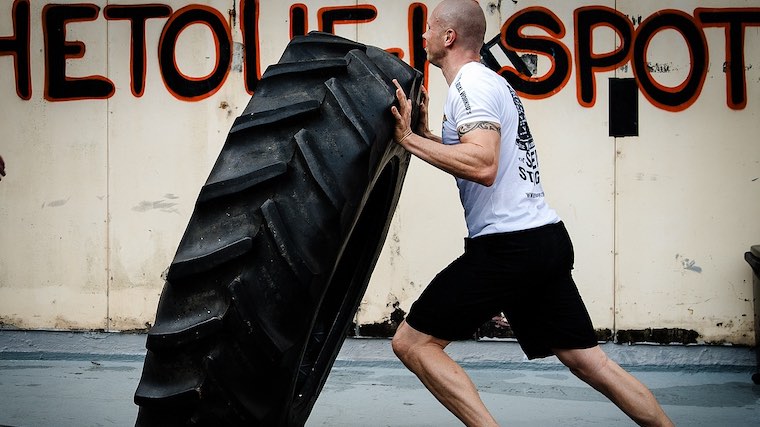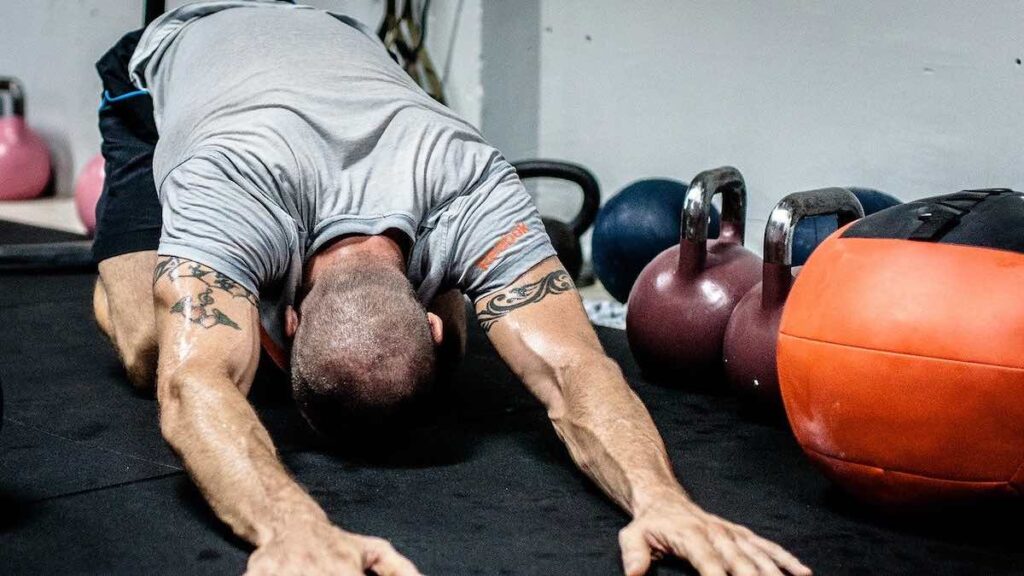Many people begin CrossFit as a path to managing their mental health. Physical activity has a host of mental health benefits, including potentially reducing anxiety and depression. However, recovery practices like sleeping enough, drinking enough water, and eating enough are sometimes neglected in favor of more training. This imbalance leads to being under recovered, a set of symptoms that have negative impacts on mental and physical health.
Editor’s note: The content on BarBend is meant to be informative in nature, but it should not be taken as medical advice. The opinions and articles on this site are not intended for use as diagnosis, prevention, and/or treatment of health problems. If you’re dealing with or exhibiting signs of depression or injury, please seek the advice of a medical professional immediately.
The Sympathetic Nervous System
We can’t understand recovery without first understanding our nervous system and its relationship to stress. The sympathetic nervous system (SNS) is responsible for preparing our bodies for perceived danger or threat. The rush of adrenaline and cortisol we feel as butterflies and an elevated heart rate before and during a workout is the SNS at work: it’s preparing us to meet a challenge through the fight-or-flight response.
This is exactly what’s supposed to happen. When we push hard in the gym, we’re putting our bodies under stress and it’s this stress that leads to fitness adaptations, like getting faster and stronger. Unfortunately, much of modern living is stressful, and a constantly active SNS has repercussions both inside and outside of the gym, which show as under recovery.
How do you know if you’re under recovered? The signs of being under recovered range from mild to severe.
Mild:
- Lethargy.
- Moodiness.
- Workouts feel harder and output is lower.
- Nagging aches and pains that don’t go away.
- Lower heart-rate variability and higher resting heart rate.
Severe:
- Depression, anxiety, or burnout.
- Plateaus in training progress.
- Losing muscle mass.
- Lack of sex drive.
- Missing or irregular periods.
- Digestive issues.
- Difficulty sleeping.
- Injuries.
- Illness.
We require recovery time in order to allow fitness adaptations to occur. Think of it this way: your body is a car and training empties your gas tank, while recovering sufficiently puts fuel back in. Failing to recover is like pushing your car vs using the gas pedal; you won’t get as far even though you may be putting in a lot more effort.
[Related: What you should know about muscle recovery.]
Top Five Recovery Mistakes CrossFitters Make
1. Not listening to the body.
Our bodies have all kinds of methods to signal when they need a break. Gastrointestinal upset, nagging injuries and illnesses, low sex drive, and being emotionally reactive are common signs that we’re under recovered and need to rest.
Denying when our bodies are telling us that we need to prioritize recovery is a recipe for burnout: that feeling of complete overwhelm followed by malaise and disinterest in training.
If you’re finding yourself with unexplained stomach aches, illnesses, or moodiness, you may need to tune in and take an unplanned rest day or two.
2. Not taking enough rest days.
All athletes need rest days. Working out every day is one of the more common reasons that training plateaus occur. Athletes who train every day (and yes, active recovery counts as training) may believe that they need to in order to reach their goals, or conversely, that rest days will get in the way of reaching their goals. This couldn’t be further from the truth.
Many athletes also use training to manage their mental health: we often find we feel better after training, and when we’re under a lot of stress we’ll turn to training more in order to manage it. Remember, however, that training is itself a form of stress. We may be making ourselves feel worse in the long run.
Your individual rest day needs will vary with any life stress; learning to listen to your body will help determine whether most rest is needed, either through rest days or active recovery days.
3. Fixating on supplements or gear.
Our brains are wired to look for the easiest, least energy-required path to getting what we want. Despite some questionable research supporting certain supplements’ effectiveness and even risk that nutritional supplements are tainted with banned or toxic substances, we would rather take a pill or mix something into a shake than make lifestyle changes that are proven to be effective for recovery.
The same applies to electronic stimulation, massage guns, and other mobility equipment like foam rollers. These are not bad or useless products, but if they make up most of our recovery practices, rather than sleeping enough, eating enough, and drinking enough water, we’re re-filling our gas tank through a straw rather than a hose.
4. Constantly under-eating.
CrossFitters often feel intense pressure to “get lean,” which is code for thin, and whether we’re calling it “cutting” or “dieting,” it’s doing the same thing: it’s putting additional stress on the body, taking even more gas out of the tank. Many people take up exercise, including CrossFit, in order to lose weight, and many of us believe that we need to be smaller in order to be successful in our athletic journey. This is simply not the case: less body fat does not automatically equal better health.
When professional athletes like weightlifters cut weight, they do so for very short periods of time so that it doesn’t have an impact on their performance. Under-eating has immediate effects on workouts, like increasing the difficulty of hitting intervals, and it has long term effects, like regressions in fitness and serious hormonal disruptions that impact sleep, mood, sex drive, and menstrual cycles.
If your diet is affecting your performance or your well-being outside of the gym, it’s time to re-evaluate.
5. Ignoring the quality and quantity of sleep.
What happens to our performance when we don’t get enough quality sleep? Sleep deprivation studies suggest that it reduces time to exhaustion and impairs cognitive function, meaning we’re fatigued more easily, less coordinated, and less emotionally stable.
Sleep hygiene refers to the practices we employ to set ourselves up to sleep enough and to sleep well, like setting a consistent bedtime and reducing alcohol intake. Sleep hygiene may be the least sexy path to drastically improving your recovery, but it is the most effective and it’s free.
The Parasympathetic Nervous System
Recovery practices are also known as hidden training: it’s everything we do to repair from the work we’ve done and prepare for the work we will do.
The purpose of recovery practices is to improve vagal nerve tone.The vagus nerve wanders down through the body, beginning in the brain stem and traveling through the larynx, the heart, and the stomach, among other organs, influencing our heart rate, digestion, sexual arousal, and more. It is a large part of the parasympathetic nervous system (PNS); this is your rest and digest mode, when the body relaxes and uses the nutrients we’ve ingested to repair and recharge.
The PNS is considered opposite to the SNS. When we have poor vagal nerve tone, our bodies find it difficult to shut off the SNS in favor of the PNS, which leads us to the symptoms of under recovery.
Ready to recover better?
Focus on the basic three: nutrition, hydration, and sleep. Dialing these in allows us to train harder and healthier, leading to more consistent progress. These form the foundation for recovery and should be the main focus of recovery efforts.
Eat enough, and eat a balance of carbohydrates, fats, and proteins that will give you the energy you need not only to get through your workouts but also to get through your days! When you’re eating enough, your energy level is steady throughout the day.
Water is life. Your body uses water for digestion, circulation, maintaining your body temperature, transporting nutrients to your cells, and more. Target 75% – 125% of your bodyweight in pounds in ounces of water. For example, a 200lb athlete would drink between 150oz and 250oz of water per day.
Sleep is often under prioritized, yet it’s the most effective way to recover better: the PNS is most active when we’re at rest. If you’ve had poor sleep hygiene for a long time, your body will need time to get used to a new routine, so don’t expect immediate gratification. Cutting off caffeine intake after 2pm, shutting off all screens at least an hour before bed, consistent bedtimes, or sleeping in a cool, dark, and quiet (or white-noise machine using) room are some simple places to start.
The mental health benefits of physical activity have to be balanced with recovery in order to take full advantage of them.

